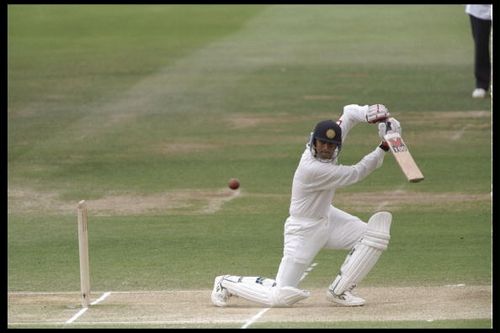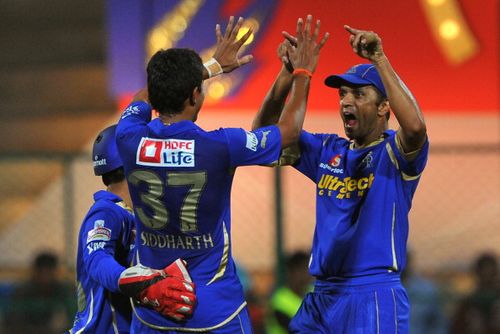
Rahul Dravid - Stamping his class on the IPL

The innings that started it all
On 22nd June, 1996, Rahul Dravid faced his first delivery in Test cricket. And with that straight-from-a-coaching-manual front foot defense, a glorious career began. A solid 95 runs and 267 balls later, every viewer knew that they had witnessed something special.
And maybe that was the fateful day the stereotype set in. Maybe it was because of his textbook drives and unbreakable defense that he was dubbed as the Wall – a nickname he hasn’t been able to get rid of even a year after retirement. Maybe it was the near-perfect leave outside the off stump, or the absolute zero gap between bat and pad, that made people conveniently conclude that he was not suited to the fast pace of ODI cricket. We love clichés. So much so, that 10,889 ODI runs later, when there were no more points left to prove, the world decided to question his ability in the shortest format – T20.
Fast forward to 18th April, 2008. The Indian Premier League’s first ever match, RCB vs KKR. Even prior to the first ball being bowled, half of the nation debated over whether Dravid was going to be a liability to his team in a format supposedly much more suited to slam-bang players, rather than those with technical brilliance. Meanwhile, KKR posted a mammoth 222 in their stipulated 20 overs. Dravid, opening the batting for RCB, was cleaned up by Ishant Sharma on the third ball of the innings, attempting to hoick Ishant over mid-on. The debate heated up. Bangalore ended up losing the match, KKR defeating them by a whopping 150 runs.
The Royal Challengers had a disastrous campaign. More questions were asked, more fingers were pointed. But akin to the rest of his underrated career, Dravid’s bat continued to do all the talking. With 371 runs to his name, he was RCB’s highest scorer in the season by a fair distance. Despite having to suffer the ignominy of being unceremoniously sacked as Bangalore skipper after RCB’s below par showing in the first season, the runs continued to flow. 271 runs in the challenging conditions of South Africa, coupled with 256 runs in the third season, ensured that Dravid remained amongst the most consistent batsmen in the RCB setup.
After the third season, the IPL player auction was eagerly awaited. Dravid had controversially put himself up for sale, against popular rumours that his IPL career was over. His long-term colleague Saurav Ganguly went unsold, while Dravid was bagged by Rajasthan Royals, a team that never seems to be anybody’s favourite. As it turned out, they were the only bidders.
Rajasthan brought about a side of Dravid most didn’t know existed. His sensible and calculated aggression was like a breath of fresh air in a team lacking any star power. He flayed the best of bowling attacks and took the attack to the opposition, switching gears with effortless ease. IPL 4 fetched him 343 runs. In IPL 5, he led the Royals with the highest degree of calmness and composure, in total contrast to Warne’s maverick ways. Easily his best season, each one of his 462 runs radiated an essence of sheer class.

Dravid’s leadership has galvanised the Royals
Speaking about Rahul Dravid and Jacques Kallis’ IPL careers recently on air, Harsha Bhogle said “Year after year critics write them off. And year after year, both of them just conjure up these massive numbers.” In 74 IPL games, Dravid has amassed 1839 runs at an exceptionally healthy average of 28.73. His strike rate of 117 is a point to be noted. After all, in a format where a strike rate of about 125 is considered to be above average, and for someone who invariably seems to shoulder the burden of anchoring the innings and batting out the twenty overs, 117 is a pretty good number.
Those impressive statistics aside, what is heartening is the fact that all of Dravid’s runs are still scored in his quintessential manner. The oh-so-stylish cover drives, the copybook straight drives, the nimble flicks off his legs, the powerful pulls and fearsome cuts are the shots that earned him his 13,288 runs in the longest format. And to his credit, those very shots have been employed by Dravid in T20 as well. Clearly, no class or grace has been compromised upon. In an era where disappointingly ugly shots are invented (Dilshan’s dilscoop and Pietersen’s switch-hit) just to notch up the pace of scoring a slight bit, Dravid is a purist’s delight. Hunting for an ugly shot in a Dravid Test innings is no easy task by any stretch of imagination. And remarkably, the task remains just as extraordinarily hard in majority of his T20 innings too.
Clearly, Rahul Dravid is not just ‘The Wall’. The word falls desperately short of encapsulating the encompassing game Dravid possesses.